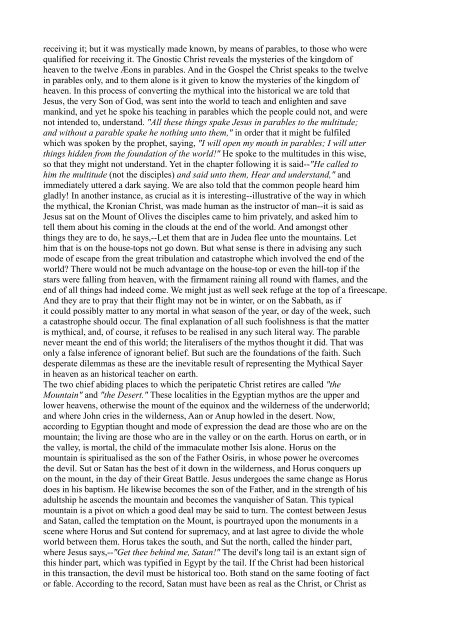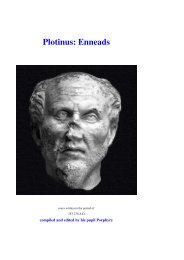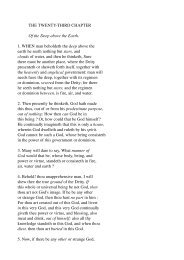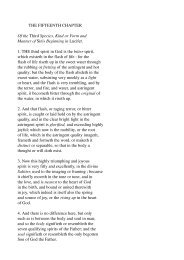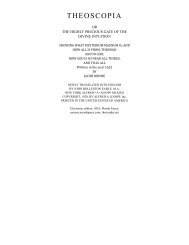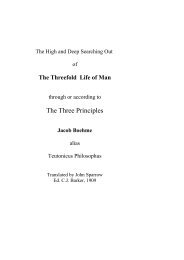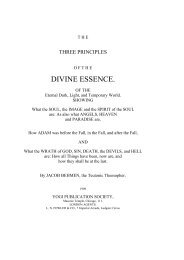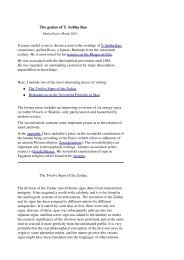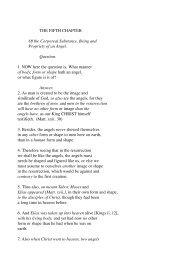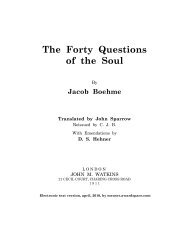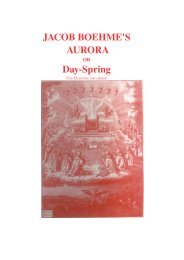Gerald Massey's Lectures - Society in evolution - Awardspace
Gerald Massey's Lectures - Society in evolution - Awardspace
Gerald Massey's Lectures - Society in evolution - Awardspace
Create successful ePaper yourself
Turn your PDF publications into a flip-book with our unique Google optimized e-Paper software.
eceiv<strong>in</strong>g it; but it was mystically made known, by means of parables, to those who were<br />
qualified for receiv<strong>in</strong>g it. The Gnostic Christ reveals the mysteries of the k<strong>in</strong>gdom of<br />
heaven to the twelve Æons <strong>in</strong> parables. And <strong>in</strong> the Gospel the Christ speaks to the twelve<br />
<strong>in</strong> parables only, and to them alone is it given to know the mysteries of the k<strong>in</strong>gdom of<br />
heaven. In this process of convert<strong>in</strong>g the mythical <strong>in</strong>to the historical we are told that<br />
Jesus, the very Son of God, was sent <strong>in</strong>to the world to teach and enlighten and save<br />
mank<strong>in</strong>d, and yet he spoke his teach<strong>in</strong>g <strong>in</strong> parables which the people could not, and were<br />
not <strong>in</strong>tended to, understand. "All these th<strong>in</strong>gs spake Jesus <strong>in</strong> parables to the multitude;<br />
and without a parable spake he noth<strong>in</strong>g unto them," <strong>in</strong> order that it might be fulfiled<br />
which was spoken by the prophet, say<strong>in</strong>g, "I will open my mouth <strong>in</strong> parables; I will utter<br />
th<strong>in</strong>gs hidden from the foundation of the world!" He spoke to the multitudes <strong>in</strong> this wise,<br />
so that they might not understand. Yet <strong>in</strong> the chapter follow<strong>in</strong>g it is said--"He called to<br />
him the multitude (not the disciples) and said unto them, Hear and understand," and<br />
immediately uttered a dark say<strong>in</strong>g. We are also told that the common people heard him<br />
gladly! In another <strong>in</strong>stance, as crucial as it is <strong>in</strong>terest<strong>in</strong>g--illustrative of the way <strong>in</strong> which<br />
the mythical, the Kronian Christ, was made human as the <strong>in</strong>structor of man--it is said as<br />
Jesus sat on the Mount of Olives the disciples came to him privately, and asked him to<br />
tell them about his com<strong>in</strong>g <strong>in</strong> the clouds at the end of the world. And amongst other<br />
th<strong>in</strong>gs they are to do, he says,--Let them that are <strong>in</strong> Judea flee unto the mounta<strong>in</strong>s. Let<br />
him that is on the house-tops not go down. But what sense is there <strong>in</strong> advis<strong>in</strong>g any such<br />
mode of escape from the great tribulation and catastrophe which <strong>in</strong>volved the end of the<br />
world? There would not be much advantage on the house-top or even the hill-top if the<br />
stars were fall<strong>in</strong>g from heaven, with the firmament ra<strong>in</strong><strong>in</strong>g all round with flames, and the<br />
end of all th<strong>in</strong>gs had <strong>in</strong>deed come. We might just as well seek refuge at the top of a fireescape.<br />
And they are to pray that their flight may not be <strong>in</strong> w<strong>in</strong>ter, or on the Sabbath, as if<br />
it could possibly matter to any mortal <strong>in</strong> what season of the year, or day of the week, such<br />
a catastrophe should occur. The f<strong>in</strong>al explanation of all such foolishness is that the matter<br />
is mythical, and, of course, it refuses to be realised <strong>in</strong> any such literal way. The parable<br />
never meant the end of this world; the literalisers of the mythos thought it did. That was<br />
only a false <strong>in</strong>ference of ignorant belief. But such are the foundations of the faith. Such<br />
desperate dilemmas as these are the <strong>in</strong>evitable result of represent<strong>in</strong>g the Mythical Sayer<br />
<strong>in</strong> heaven as an historical teacher on earth.<br />
The two chief abid<strong>in</strong>g places to which the peripatetic Christ retires are called "the<br />
Mounta<strong>in</strong>" and "the Desert." These localities <strong>in</strong> the Egyptian mythos are the upper and<br />
lower heavens, otherwise the mount of the equ<strong>in</strong>ox and the wilderness of the underworld;<br />
and where John cries <strong>in</strong> the wilderness, Aan or Anup howled <strong>in</strong> the desert. Now,<br />
accord<strong>in</strong>g to Egyptian thought and mode of expression the dead are those who are on the<br />
mounta<strong>in</strong>; the liv<strong>in</strong>g are those who are <strong>in</strong> the valley or on the earth. Horus on earth, or <strong>in</strong><br />
the valley, is mortal, the child of the immaculate mother Isis alone. Horus on the<br />
mounta<strong>in</strong> is spiritualised as the son of the Father Osiris, <strong>in</strong> whose power he overcomes<br />
the devil. Sut or Satan has the best of it down <strong>in</strong> the wilderness, and Horus conquers up<br />
on the mount, <strong>in</strong> the day of their Great Battle. Jesus undergoes the same change as Horus<br />
does <strong>in</strong> his baptism. He likewise becomes the son of the Father, and <strong>in</strong> the strength of his<br />
adultship he ascends the mounta<strong>in</strong> and becomes the vanquisher of Satan. This typical<br />
mounta<strong>in</strong> is a pivot on which a good deal may be said to turn. The contest between Jesus<br />
and Satan, called the temptation on the Mount, is pourtrayed upon the monuments <strong>in</strong> a<br />
scene where Horus and Sut contend for supremacy, and at last agree to divide the whole<br />
world between them. Horus takes the south, and Sut the north, called the h<strong>in</strong>der part,<br />
where Jesus says,--"Get thee beh<strong>in</strong>d me, Satan!" The devil's long tail is an extant sign of<br />
this h<strong>in</strong>der part, which was typified <strong>in</strong> Egypt by the tail. If the Christ had been historical<br />
<strong>in</strong> this transaction, the devil must be historical too. Both stand on the same foot<strong>in</strong>g of fact<br />
or fable. Accord<strong>in</strong>g to the record, Satan must have been as real as the Christ, or Christ as


